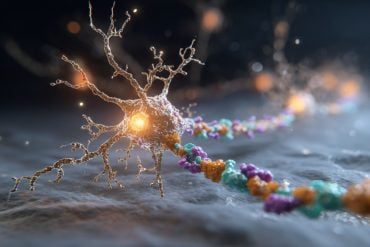Summary: A new study reveals intriguing insights into how our brains perceive different quantities of objects.
When faced with a small number of items (four or fewer), our brains can quickly and accurately determine the count, a phenomenon known as “subitizing.” Conversely, with five or more items, our estimation becomes increasingly imprecise and time-consuming.
The research suggests that while neurons in our brain are designated for perceiving each number, the mechanism is sharper and more accurate for smaller numbers, and a different, less accurate processing method seems to be employed for larger numbers.
Key Facts:
- Subitizing vs. Estimating: The brain employs two distinctive mechanisms for number processing: “subitizing” for quick and accurate perception of smaller numbers (four and under), and a less precise estimation method for larger numbers (five and above).
- Neural Selectivity: Neurons dedicated to small numbers are more selective and precise, inhibiting nearby neurons (e.g., neurons for “two” or “four” when “three” is presented) to reduce error, a mechanism not present for larger numbers.
- Real-world Applications: This research, through understanding how our brain processes numbers, could potentially pave the way to better comprehend developmental disorders like dyscalculia.
Source: University of Bonn
When two, three or four apples are placed in front of us, we are able to recognize the number of apples very quickly. However, we need significantly more time if there are five or more apples and we often also guess the wrong number. In fact, the brain does actually register smaller numbers of things differently than larger ones.
This has been demonstrated in a recent study by the University of Tübingen, University of Bonn and the University Hospital Bonn.
The results were published in the magazine Nature Human Behaviour.
Imagine that somebody shows us a photo of a string quartet and asks us to say how many people there are in the picture. There is not enough time to count them but we can all answer like a shot: “Four!” The next picture shows a septet and again we are only given enough time to take a quick look. We hesitate and are not quite so confident this time: “Eight.” The correct number is actually seven but we were very close.
There seems to be two distinctive ways in which we as humans tend to process numbers of things: We are usually able to detect small numbers of things very quickly and correctly. This is also described as “subitizing” in research circles. However, this method changes suddenly when there are five elements or more: We need more and more time to answer and our answers become increasingly imprecise.
Some researchers have thus speculated that there are two different processing methods in the brain – a precise one for small numbers and an estimation mechanism for larger numbers of things.
“However, this idea has been disputed up to now,” explains Prof. Florian Mormann from the Department of Epileptology at the University Hospital Bonn, who carries out research at the University of Bonn. “It could also be that our brain always makes an estimate but the error rates for smaller numbers of things are so low that they simply go unnoticed.”
The neurons for smaller numbers of things are more selective
The recent study actually indicates, however, that we do indeed process small and large numbers of things differently. The research groups involved in the project were able to demonstrate some years ago that the brain has nerve cells responsible for each number. Some neurons fire, for example, primarily for two elements, other for four elements and again others for seven elements.
“However, the neurons also fire in response to slight variations in the number,” explains Prof. Andreas Nieder from the University of Tübingen, who was the other main author of the study alongside Mormann.
“A brain cell for a number of “seven” elements thus also fires for six and eight elements but more weakly. The same cell is still activated but even less so for five or nine elements.”
Nieder has already been able to demonstrate this “numerical distance effect” in experiments on monkeys. Interestingly, this effect only appears to occur in humans at higher numbers. “There seems to be an additional mechanism for numbers of around less than five elements that makes these neurons more precise,” says the neurobiologist.
When a brain cell for a number of three things fires, it simultaneously inhibits the brain cells for the numbers two and four. This reduces the risk that these cells will also incorrectly fire for the number three. However, this mechanism does not exist for the neurons activated for numbers five, six or eight. This is why there is a higher error rate for these numbers.
Observing individual brain cells at work
A special feature of the University Hospital Bonn benefited the researchers in their study: The Department of Epileptology at the hospital specializes in brain surgery. The doctors there try to treat epilepsy by carrying out operations to remove the diseased nerve tissue. In order to identify the location of the epileptogenic focus, they sometimes first insert electrodes into the affected person’s brain.
Seventeen patients participated in the latest study. In preparation for their operations, microelectrodes as fine as a human hair were inserted into the temporal lobe. “We were able to use them to measure the reaction of individual nerve cells to visual stimuli,” explains Esther Kutter, who carried out a large proportion of the experiments for her doctorate in the research group headed by Prof. Mormann.
The test subjects were seated in front of a computer screen on which different numbers of dots appeared for half a second. The participants were then asked to state whether they had seen an even or odd number of dots.
They were able to respond very quickly and made practically no mistakes up to a number of four dots. After that, the number of errors increased with the number of dots, as did the amount of thinking time that the participants needed to complete their task.
This work will open up new insights into how numbers are processed in the human brain. In the long term, the findings could lead to a better understanding of dyscalculia, a developmental disorder associated with a poor understanding of numbers.
Participating institutes and funding:
The University of Tübingen, the University of Bonn and the University Hospital Bonn participated in the study.
Funding: The research was funded by the German Research Foundation (DFG), the German Federal Ministry for Education and Research (BMBF) and the iBehave Research Network in the State of North Rhine-Westphalia.
About this neuroscience research news
Author: Johannes Seiler
Source: University of Bonn
Contact: Johannes Seiler – University of Bonn
Image: The image is credited to Neuroscience News
Original Research: Closed access.
“Distinct neuronal representation of small and large numbers in the human medial temporal lobe” by Florian Mormann et al. Nature Human Behavior
Abstract
Distinct neuronal representation of small and large numbers in the human medial temporal lobe
Whether small numerical quantities are represented by a special subitizing system that is distinct from a large-number estimation system has been debated for over a century. Here we show that two separate neural mechanisms underlie the representation of small and large numbers.
We performed single neuron recordings in the medial temporal lobe of neurosurgical patients judging numbers. We found a boundary in neuronal coding around number 4 that correlates with the behavioural transition from subitizing to estimation.
In the subitizing range, neurons showed superior tuning selectivity accompanied by suppression effects suggestive of surround inhibition as a selectivity-increasing mechanism. In contrast, tuning selectivity decreased with increasing numbers beyond 4, characterizing a ratio-dependent number estimation system.
The two systems with the coding boundary separating them were also indicated using decoding and clustering analyses.
The identified small-number subitizing system could be linked to attention and working memory that show comparable capacity limitations.







